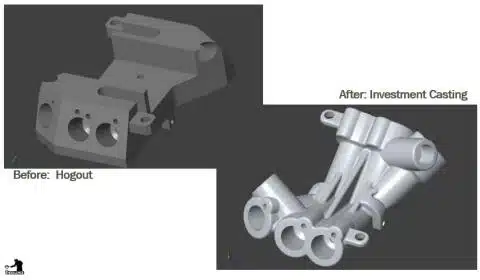
I was looking at an Investment Casting Institute publication entitled Case Studies and Applications which elaborates on the substantial savings realized when fabricated assemblies are converted to One-Piece castings. In that Investment Casting is such an effective manufacturing method for realizing this type of savings one wonders why companies don’t place greater emphasis on achieving them. Perhaps their not knowing a good place to look to find a casting conversion candidate is the answer.
The Investment Casting process provides two main cost benefits to its customers. First is its Near-Net-Shape capability that stems from the dimensional precision of the process and that no draft angle is required. Secondly the Investment Casting process provides an ability to combine multiple pieces into a One-Piece structure with few design constraints and without a major impact to cost. With easily machined alloys, such as aluminum, the One-Piece advantage takes on a greater significance than does Near-Net-Shape.
Considering this, then the most ready opportunities to realize a significant savings from a conversion to an aluminum investment casting is to find situations where components are being assembled together either with a fastener, braze or weld. Weldments and Dip Brazed assemblies are obvious candidates to becoming Investment Castings.
The direct savings from the elimination of an assembly operation can be substantial but the indirect savings from a reduction of Part Count can be even larger. One-Piece cast structures also lower the risk of assembly point failures with the additional benefit of the Near-Net-Shape precision of the investment casting process and potential for component weight reduction.
Investment Castings present a cost effective method for the manufacture of complex and near-net shapes. Replacing fabricated structures with One-Piece castings is a good starting point to achieve substantial savings.
